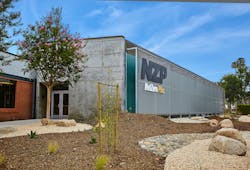The Net Zero Plus Electrical Training Institute
City of Commerce, Calif.
PHOTO CREDIT:
© ETI
Many equate net-zero buildings with significant solar power arrays. While renewables are a key component to any net zero energy project, there is a lot more to it than just PV. If anyone ought to know, it’s Brett Moss, training director for the L.A. County IBEW/NECA Electrical Training Institute. A 2016 complete retrofit, the school, prior to the deep-energy technology additions, already had nearly ¾ MW worth of PV on site, but that year, emerged from its cocoon, so to speak, to become the Net Zero Plus ETI, a 142,000 sq. ft., net-positive facility which generates nearly a megawatt’s worth of power, while only consuming about 740,000 kWh. While that’s a lot of renewable power, Moss notes it was other improvements, a new R30 roof, LED lighting, a more efficient HVAC system—and most important of all, energy storage—that allowed the transformation. “Microgrids with energy storage are a game changer,” says Moss. “In fact, we believe the project is the model for the emergency services centers of tomorrow.”
Being an institution for instructing electricians in the latest/greatest, having and using PV on site was a natural for this “living laboratory.” But prior to the net zero retrofit, other than its curriculum benefits, the existing PV, despite being one of the largest installations of its kind at the time in 2004, didn’t have as significant an impact as the newly created smart microgrid because the PV didn’t have a mission. “If the utility went down, so did we,” said Moss. However, with the addition of energy storage and bi-directional inverters from Dynapower, the facility now can go off the grid any time it wants (islanding) by supporting that effort with the power stored in the batteries, which of course, are powered by PV. This is critical in terms of emergency services centers—hospitals, any first responders and the like—as Moss says it is really about establishing security and peace of mind through energy independence. “Resiliency is absolutely the biggest driver,” says the director.
Daylighting Dynamics
Not only was harnessing the sun for power critical to the 24/7 operation, so was harvesting it to reduce lighting energy comsumption. At the same time, glare and visual comfort had to be considered. Glare is partially addressed in the office areas with a metal mesh screen that fronts pre-existing opaque channel glass. Elsewhere, the school turned to a more sophisticated solution—electrochromic glazing. Donated by SageGlass, the innovative glazing technology helps the facility manage solar heat gain on the east elevation while maximizing natural light without the need for any kind of manual or automated shading. The Lightzone glazing installed is also used in the main conference room which is extremely helpful in darkening the room for presentations.
Beyond Lightzone's ability to tint at three different levels, or "zones," to maximize comfort, while letting in the most natural light, with the manufacturer's help, the school was able to spell out its initials in a mozaic of tint that allows a nice touch of branding. "We have to be early adopters," says Moss. You cannot be a leader if you're always chasing. Our guys want to know this stuff—they very much want to be part of doing the right thing and being part of the solution. We need to be ready."
